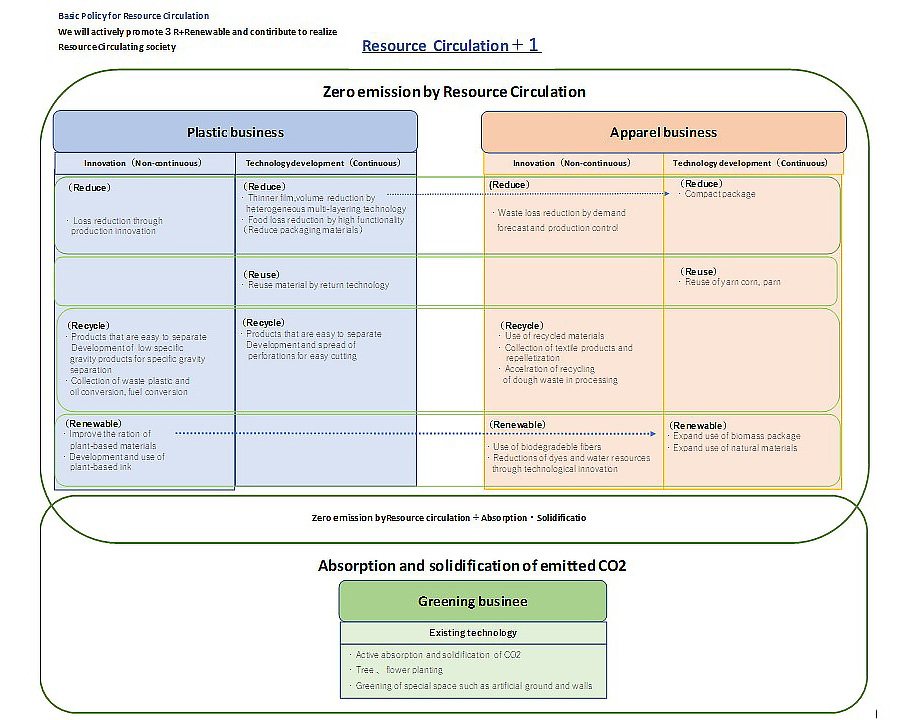Resources circulation in the field of plastic and apparel
GUNZE LIMITED
Outline
In January 2020, GUNZE has established a Basic Policy for Plastic Resource Circulation, and clarified “The Responsibilities for manufacturing and consuming” on our materiality of Sustainable Development Goals. This project is currently focused mainly on the Plastic business. However, GUNZE manages businesses centered on Apparel and Plastic, it will be necessary for the entire group to focus mainly on both businesses. The project aims to minimize the amount of plastic and textile waste generated in the manufacturing process by market prediction and optimal design, as well as promote recycling into oil and re-pelletizing. In addition, it also contributes to reducing environmental impact by converting to use bio-based materials from petrochemical raw materials, making films thinner and changing to more compact packaging. This challenge will reduce CO2 emissions by circulating all the resources of both businesses. In addition, it will also strengthen zero emission promoting system by promoting the active absorption and solidification of CO2 through our greening business. This cross-functional approach in different business fields will be one of the model cases of material circulation among industries.
Description
1. Attainment target(Development、Implementation、Cost etc.)
Circulate all resources related to both businesses with 2050 as the attainment target.
2. Tasks to overcome for materialization
2-1. Tasks of Plastic business
・ Materialize a same functional film as the current one with bio-based materials (T)
・ Technology for advanced analyzing market circumstance(include weather) and forecasting demand(T)
・ Technology for separating highly combined heterogeneous-multilayer materials(films) for recycling(T)
・ Highly efficient oil and fuel conversion of waste plastic(T)
2-2. Tasks of Apparel business
・ Achieve same or lower price than current with bio-based materials (C)
・ Technology for materializing same comfort with recycled raw materials as virgin ones (T)
・ Acquisition or development of bio-based(biodegradable) fibers that are having same functions as synthetic ones(T)
・ Stimulation for environmental cost awareness and resolution of social system(S)
2-3. Tasks of Greening business
・ Keep the producers(P)
・ Expansion of green area(P)
3. Concrete actions
As shown on the attached chart「Resource circulation+1」
Overall, reduce the ratio of petrochemical materials and circulate all resources in our plastic business and Apparel business. Furthermore we will achieve zero
emissions through our greening business by actively promoting carbon dioxide absorption and solidifications.
Along with 3R+Renewable, we show our concrete technologies for achieving resource circulation by dividing continuous actions and non-continuous ones as below.
Resource Circulation
【Reduce】
(Technology development Continuous)
We will reduce (volume reduction) petrochemical raw materials in our plastic business through evolving the technology of thinning by heterogeneous multi-layering that we have been working for more than 10 years, and same time we will reduce packing materials in apparel business by changing to compact size packaging.
As an incidental effect, in food packaging applications, added high functional heterogeneous-multilayer technology enable to extend the shelf life of foods, and this also leads to the waste reduction (volume reduction).
(Innovation Non-continuous)
By improving the market analysis method, we eliminate the waste during production and reduce the waste loss.
We will reduce petrochemical raw materials by combination using of technology-development + innovation, making packaging materials thinner, and smaller
【Reuse】
(Technology development Continuous)
In our plastic business, we will recycle the loss goods during processing into raw materials and produce the products (Return technology).
【Recycle】
(Technology development Continuous)
If it is difficult for the user (consumer) to separate the packaging waste after use, the psychological cost may increase and this may be a hindrance for raising the awareness of separating. Therefore we reduce the psychological cost and increase the recycling rate by designing our films easy to separate.
(Innovation Non-continuous)
The heterogeneous multilayer films that separated above is composed with multiple materials for achieving its function, and need to be separated for recycling into mono material.
Now there is no separation technology in the world, so we need to construct a heterogeneous multilayer technology that enable specific gravity separation. In addition, we will establish technologies to convert plastic waste during processing and fabric waste into oil, fuel, re-pellet, and recycled fibers for resource circulation without disposing them as waste.
And concerning the collection and recycling of plastic and textile products discharged to the market, we need to corporate with distribution(and retail) industry and recyclers with open innovation.
【Renewable】
(Innovation Non-continuous)
As well as reducing and circulating resources derived from petrochemical through 3R, it is a very important mission to make root materials into recycled materials. We will gradually increase the ratio of plant-based materials in plastics and the usage ration of biomass packages/biodegradable fibers in apparel. Finally we will raise the ratio of using bio-based materials to the limit for almost all our products.
+1
In addition to zero emissions of resource circulation by 3R+Renewable, we will actively absorb and solidify CO2 through greening such as planting in our greening business.
In promoting our initiatives, we will set up internal promoting system, targeting to the 100% Resource Circulation in 2050, and manage the progress by KPI settings using the back-casting method.
4. Quantitative effects when our challenge is realized
Plastic waste recycling rate during plastic production : 100%
Dough waste recycling rate during apparel production : 100%
Solidify and absorb CO2 through greening business : Calculation impossible
Similar Innovation Challenges
Accelarating the penetration of renewable energy resources with “Open Energy System”
Sony Group Corporation
Achieving net-zero carbon emissions from plant factories using full artificial lighting
Taikisha Ltd.
Advanced technology for buildings providing energy-saving and comfortable indoor environment (under Net Zero Energy condition)
Mitsubishi Electric Corporation
AI control reduces base station power consumption by up to 50%
KDDI CORPORATION







